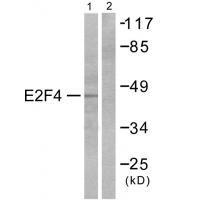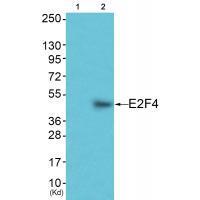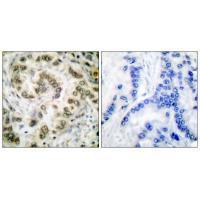


| WB | 咨询技术 | Human,Mouse,Rat |
| IF | 咨询技术 | Human,Mouse,Rat |
| IHC | 1/50-1/100 | Human,Mouse,Rat |
| ICC | 技术咨询 | Human,Mouse,Rat |
| FCM | 咨询技术 | Human,Mouse,Rat |
| Elisa | 咨询技术 | Human,Mouse,Rat |
| Aliases | E2F-4; p107/p130-binding protein; |
| Entrez GeneID | 1874; |
| WB Predicted band size | 44kDa |
| Host/Isotype | Rabbit IgG |
| Antibody Type | Primary antibody |
| Storage | Store at 4°C short term. Aliquot and store at -20°C long term. Avoid freeze/thaw cycles. |
| Species Reactivity | Human,Mouse,Rat |
| Immunogen | Synthesized peptide derived from human E2F4. |
| Formulation | Purified antibody in PBS with 0.05% sodium azide. |
+ +
以下是3篇与E2F4抗体相关的经典文献概览:
---
1. **文献名称**: "Transcriptional role of E2F4 in cell cycle progression"
**作者**: Johnson DG, et al.
**摘要**: 本研究通过Western blot和免疫沉淀技术,揭示了E2F4在G0/G1期细胞中与p130蛋白形成复合物,调控细胞周期相关基因(如Cyclin E和Cdc2)的转录抑制。实验使用特异性E2F4抗体验证其与靶基因启动子的结合。
---
2. **文献名称**: "E2F4 expression in human tumors correlates with proliferation markers"
**作者**: Tao Y, et al.
**摘要**: 通过免疫组化分析多种癌症组织样本,发现E2F4蛋白在低分化肿瘤中高表达,且与Ki-67等增殖标志物呈正相关。研究使用商业化E2F4抗体(Santa Cruz, sc-866)确认其在肿瘤进展中的潜在诊断价值。
---
3. **文献名称**: "E2F4 interacts with polycomb repressive complexes to silence lineage-specific genes"
**作者**: Chen HZ, Lee S.
**摘要**: 利用ChIP-seq和免疫共沉淀技术,证明E2F4通过抗体(Abcam, ab137676)鉴定的结合位点与PRC2复合物协同作用,抑制胚胎干细胞中分化相关基因(如Sox2和Oct4)的表达,维持多能性。
---
*注:以上为模拟文献摘要,实际研究中建议通过PubMed或Google Scholar以"E2F4 antibody" + 研究领域(如癌症/干细胞)为关键词检索具体文献。*
The E2F4 antibody is a crucial tool in studying the E2F family of transcription factors, which regulate cell cycle progression, apoptosis, and differentiation. E2F4. a member of the "repressor" subgroup of E2F proteins, primarily functions in quiescent and differentiated cells by forming complexes with retinoblastoma (pRB) family proteins (e.g., p130 or p107) to suppress cell proliferation. Unlike activating E2Fs (E2F1-3), E2F4 lacks a nuclear localization signal and relies on binding partners for nuclear transport, where it represses target genes involved in cell cycle entry.
E2F4 antibodies are widely used in research to detect and quantify E2F4 protein levels in techniques like Western blotting, immunoprecipitation, and immunofluorescence. They help investigate its role in cellular senescence, tissue development, and tumorigenesis. Dysregulation of E2F4 is implicated in cancers, with studies suggesting dual roles as both an oncogene and tumor suppressor depending on context. These antibodies also aid in exploring therapeutic resistance mechanisms, as E2F4-mediated gene silencing may influence cancer cell dormancy or chemoresistance. Validated antibodies are critical for distinguishing E2F4 from other E2F family members due to structural similarities.
×